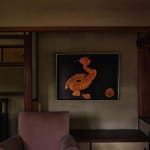Morita Shiryū (1912–1998)
Megumi
Aluminum flake pigment and lacquer on paper, framed
c. 1969
With a label signed by Inada Sousai
77 x 106 cm
82 x 111 cm (overall)
c. 1969
With a label signed by Inada Sousai
77 x 106 cm
82 x 111 cm (overall)
Literature
Morita Shiryu Catalogue Raisonné: 1952–1998. Uji: Soryusha, 2019.
Megumi is another of the characters that Morita wrote a lot. Out of thirty-seven known works, the majority of thirty-three was written in only one year, 1969. Among these, six use the shikkin (lacquer and gold) technique, including the present one.
It is a curious work, with the shape of the character resembling a swan with its long neck, walking over the ground on its webbed feet. Of the almost thirty works of the same year done in ink on paper, many of them likewise suggest the shape of birds. However, they remind of fast-running large birds such as the ostrich, an effect that is further accentuated by the texture of the brush with its hairs splitting. By contrast, the present Megumi, done in shikkin, has a much calmer, resting expression. It is telling of Morita’s skillfulness that he was able to exploit the qualities of different techniques to his advantage.
In Works of Shiryu Morita: Selected by the Artist, the word megumi is translated as “grace” (another possible translation is “blessings”). Just like in the phrase “the blessings from nature,” Morita liked to emphasize the blessings of life and existence. To give the character a shape inspired from nature (namely, a bird) therefore is not particularly unusual.
Morita Shiryu (avant-garde calligrapher; 1912–1998)
Avant-garde calligrapher from Hyogo Prefecture. Like fellow artist Inoue Yuichi, Morita studied under the calligraphy master Ueda Sokyu. He co-founded the avant-garde group Bokujinkai together with Inoue and was the founder and editor of the journal Bokubi (Beauty of Ink), both of which revolutionized traditional Japanese calligraphy and spread knowledge of Japanese avant-garde calligraphy to an international audience. He was posthumously awarded the Medal of Honor with Dark Blue Ribbon.
It is a curious work, with the shape of the character resembling a swan with its long neck, walking over the ground on its webbed feet. Of the almost thirty works of the same year done in ink on paper, many of them likewise suggest the shape of birds. However, they remind of fast-running large birds such as the ostrich, an effect that is further accentuated by the texture of the brush with its hairs splitting. By contrast, the present Megumi, done in shikkin, has a much calmer, resting expression. It is telling of Morita’s skillfulness that he was able to exploit the qualities of different techniques to his advantage.
In Works of Shiryu Morita: Selected by the Artist, the word megumi is translated as “grace” (another possible translation is “blessings”). Just like in the phrase “the blessings from nature,” Morita liked to emphasize the blessings of life and existence. To give the character a shape inspired from nature (namely, a bird) therefore is not particularly unusual.
Morita Shiryu (avant-garde calligrapher; 1912–1998)
Avant-garde calligrapher from Hyogo Prefecture. Like fellow artist Inoue Yuichi, Morita studied under the calligraphy master Ueda Sokyu. He co-founded the avant-garde group Bokujinkai together with Inoue and was the founder and editor of the journal Bokubi (Beauty of Ink), both of which revolutionized traditional Japanese calligraphy and spread knowledge of Japanese avant-garde calligraphy to an international audience. He was posthumously awarded the Medal of Honor with Dark Blue Ribbon.



